Green Crystal Technology™ -NDK Environment Support-
Green Crystal Technology™ -NDK Environment Support-
NDK has established and is promoting a midterm plan with concrete reduction targets to reduce CO2 emission which is the cause of global warming. It is also contributing to reduction (suppression) of CO2 emission by using the most advance technologies to realize minimization as well as reduction of product weight and power consumption to support the needs of society.
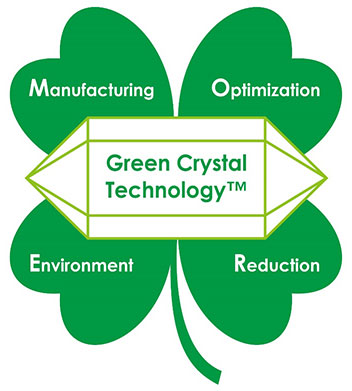

NDK's new concept of crystal devices.
Initiatives to improve total energy saving contribution and environmental performance through product life cycle.
These are the pillars for the initiatives.
Manufacturing -Environment-friendly production-
We would introduce some cases finding the amount of CO2 emission for product life cycle using environment LCA method.
(*) LCA means "Life Cycle Assessment", which involves assessing the life of a product. Here, the product life is not just the manufacturing stage of the product itself, but rather includes the mining stage of raw materials that make up the product, the manufacturing stage of parts/materials that comprise the product, the distribution stage that includes up to delivery of the product to the user, the usage stage including usage of the product by the user and repair/maintenance involved with it, and the disposal stage where products discarded by the user are reused, recycled or disposed of. International standards among the ISO14000 Series which is environmental ISO are also established for LCA.

Environmental LCA study results for clock oscillators
Amount of CO2 emitted by the ultra-low voltage drive (0.8V~) type clock oscillator (NZ2520SF) developed using the most advanced technologies and the conventional product (2700 Series) were compared by the environmental LCA technique.
The amount of CO2 emission was calculated by amount of power consumption of part manufacturing, product manufacturing and our products incorporated into laptop computers, as well as fuel consumption for product transport.
The analysis method applied was "site type", which studies power consumption by factory and manufacturing line units then find power consumption per product from the total amounts of manufactured products.
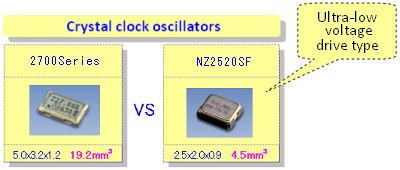
Comparison of CO2 emission reduction of crystal clock oscillators(2700 Series VS NZ2520SF)
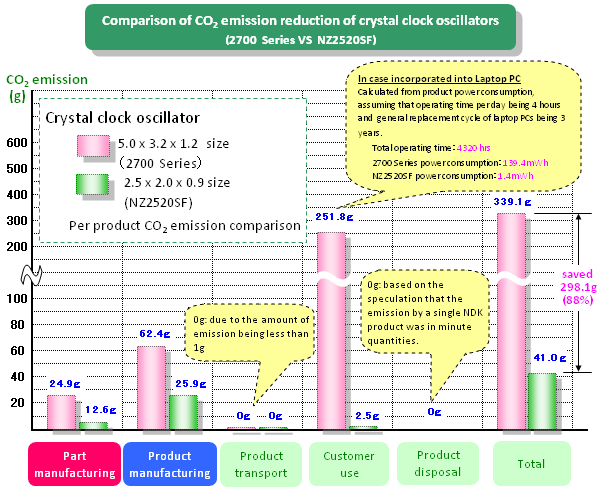
Details of part manufacturing and CO2 reduction comparison in part manufacturing are as follows.
ECO parts -Environment-friendly production-
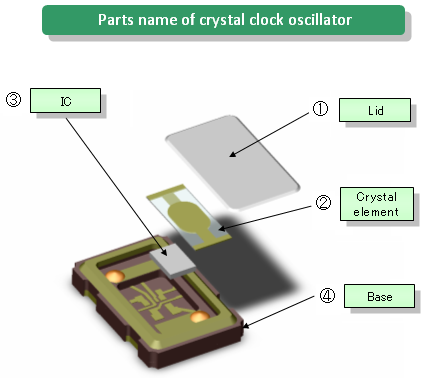
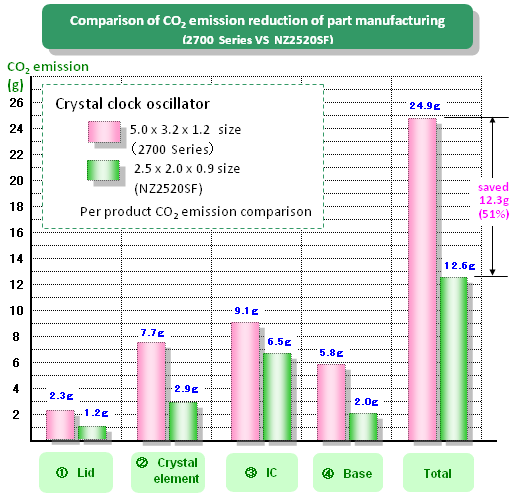
ECO manufacturing -Environment-friendly production-
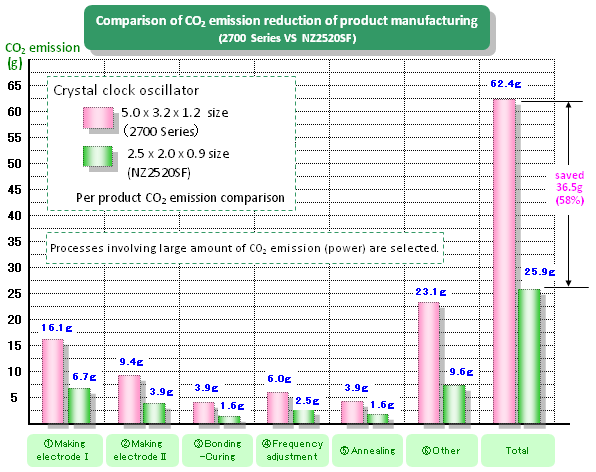
Because manufacturing involves processing at high temperature, there are processes that require large amount of power. The number of parts introduced per process can be increased by making products more compact. Power consumption of equipment hardly affects the number of parts introduced. Therefore, power consumption per product is reduced due to the increased number of parts and then CO2 emission is suppressed. Associated with this reform, reduction of power consumed for equipment was also implemented.
The equipment is as follows.
- ①Making electrodeⅠ
- Sputter equipment - -
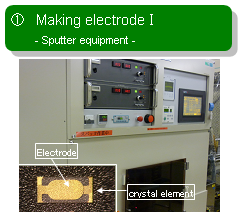
Process whereby electrodes are formed on crystal element
- ②Making electrodeⅡ
- Oven - -
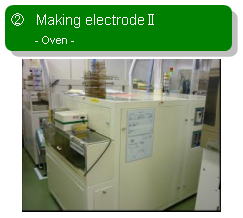
Process where electrode film is stabilized on crystal element
- ③Bonding-Curing
- Oven - -
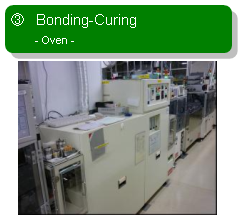
Process where crystal element is bonded to base
- ④Frequency-adjustment
- Adjustment machine - -
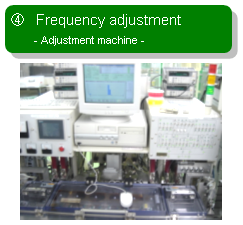
Process where electrode film of crystal element is adjusted and frequency is set to specified value
- ⑤Annealing
- Oven - -
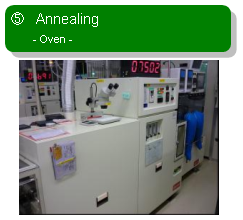
Process for stable sealing
Optimization -Energy saving contribution by improved performance/efficiency-
The development of the world's first* ultralow power-driven (0.8V min) crystal clock oscillator
Recently, eco-friendly products have become popular in various applications, and the move towards energy conservation has accelerated. For this reason, there is a strong demand for electronic components constituting these products to be environment-friendly, and due to the requirements for long-life battery and multi-functionality, energy conservation through both miniaturization and power saving is desired especially in compact devices such as mobile phones or handheld devices. In order to meet these market needs, we have developed a crystal clock oscillator that can be operated at ultralow power (0.8V min).
"NZ2520SF" is the world's first* 2.5 x 2.0 mm type crystal clock oscillator that can be operated at ultralow power (0.8V min). In comparison with existing crystal clock oscillators, the operating voltage is about 50% lower and the current consumption is at least 40% lower (Fig.1). This is equivalent to approximately 70% reduction in power consumption.
This product helps achieve low-power operation, has significant increase in battery life and reduction in environmental load especially in mobile devices such as multi-functional mobile phones, silicon audio players, PND (Personal Navigation Device)and laptop computers. Due to its wide frequency range (1.5 to 50MHz), other than mobile application devices, it can be used in a wide range of electronic devices, leading to environmental load reductions in various fields in the electronics industry.
(* Research by NDK as of June 25, 2009)
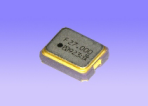
【Model name】
NZ2520SF
【Features】
Ultralow operating voltage : +0.9V±0.1V
Wide frequency range : 1.0MHz~ 50MHz
Surface mount device (SMD)
Pb-free, compliant with RoHS
Comparison of the current consumption between NDK existing product & the new NZ2520SF product (Operating voltage is about 50% lower and the current consumption is at least 40% lower)
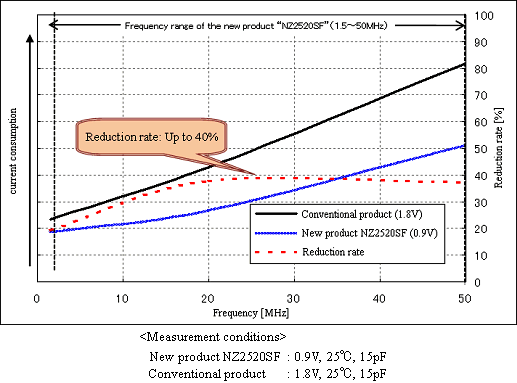
Reduction -Elminiation/reduction of substances creating environmental load-
Product development using most advanced technologies
In order to quickly respond to our customers needs, we have integrated our fundamental technology, design technology, production technology as well as manufacturing technology, to succeeded in minimization and weight reduction of products using the most advanced technologies.
We would introduce some cases concerning the minimization and weight reduction of clock oscillators used as reference clock in various products such as laptop computers.
Minimization and weight reduction of clock oscillators
The following figure shows our journey to minimize clock oscillators.
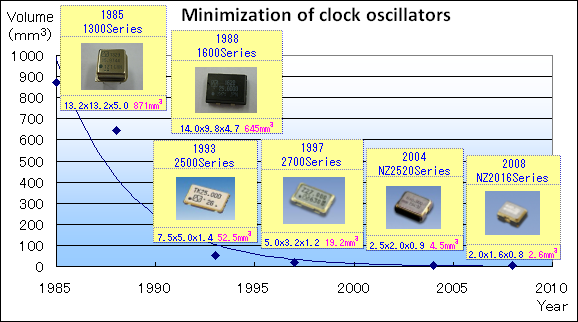
The following figure shows our journey to reduce the weight of clock oscillators.
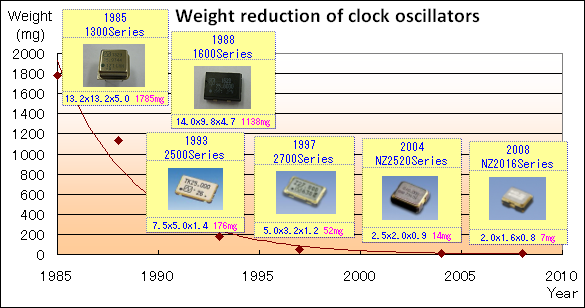
Weight reduction of laptop computers
Around 1990, when laptop computers that are indispensible for a comfortable social life were introduced, the product weight has been about 8kg. In recent years, as a result of considering convenience and the environment, the weight has been reduced to 1/10 or less of its original weight associated with the introduction of netbooks. Minimization and reduction in power consumption of laptop computers are also promoted.
Along with minimization and reduction of weight and power consumption, CO2 emission has been reduced (suppressed). Our crystal devices (clock oscillators, crystal controlled oscillators, etc.) also contribute to CO2 emission reduction (suppression) as important parts for laptop computers.
The following figure shows our journey to reduce the weight of laptop computers (examples).
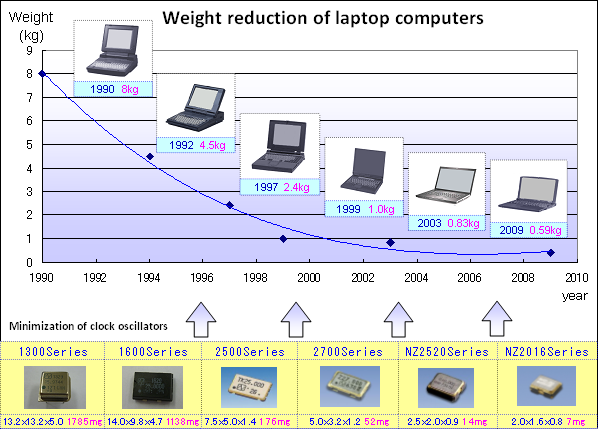
Car electronics contributing to CO2 emission suppression
In some cases, our products are indirectly contribute to CO2 emission reduction (suppression) through being used as application (customer product).
The products shown in the following figure (crystal controlled oscillators, crystal oscillators, etc.) are used for car electronics. We will introduce an example where the system would have an effect on CO2 emission reduction (suppression).
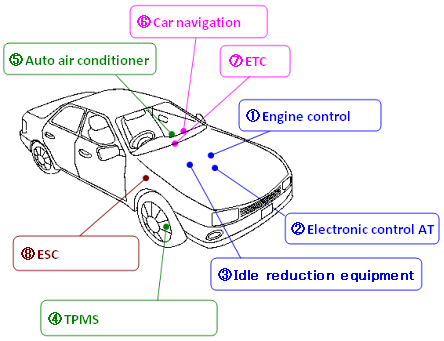
-
Power train
- Engine control
Suppresses CO2 emission by controling the engine's fuel injection equipment to raise fuel - Electronic control AT
Suppresses CO2 emission by automatically selecting the proper gear according to the driving environment (load) to realize efficient driving. - Idle reduction
Suppresses CO2 emission by eliminating idling when stopped. -
Body control
- TPMS (Tire Pressure Monitoring System)
Suppresses CO2 emission by monitoring tire air pressure to prevent fuel deetrioration caused by driving under low air pressure. - Auto air condition
Suppresses CO2 emission by holding down excess power consumption by automatically controlling temperature inside a car. -
Information communication
- Car navigation
Suppresses CO2 emission by reducing travel loss using traffic jam information or GPS information. -
ETC
Suppresses CO2 emission by reducing travel loss from stopping at toll booths. -
Vehicle control
-
ESC (Electronic Stability Control)
Suppresses CO2 emission by detecting road condition and preventing skidding and wheelspin.
Environmental Compliance with environmental laws/regulations -System that manages substances creating environmental load-
In order to control chemical substances contained in the parts and materials that comprise our products and to provide information required by EU REACH regulations, NDK collects chemical substance content data for parts/materials from suppliers, puts it in a database; through these activities, NDK is addressing to REACH regulations.
NDK responds to customers requirements, such as chemSHERPA promoted by JAMP, and IMDS, CAMDS, JAPIA sheet recommended by onboard equipment manufacturers, and etc.
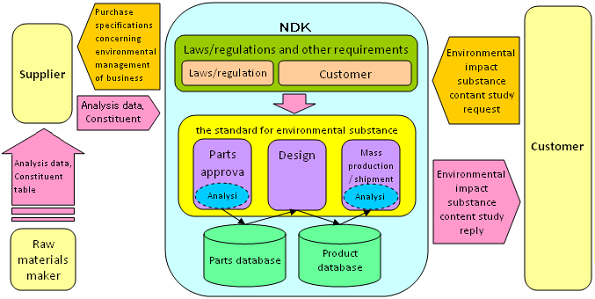
- JAMP=Joint Article Management Promotion-consortium
- IMDS=International Material Data System
- CAMDS=China Material Data System
- JAPIA=Japan Auto Parts Industries Association
